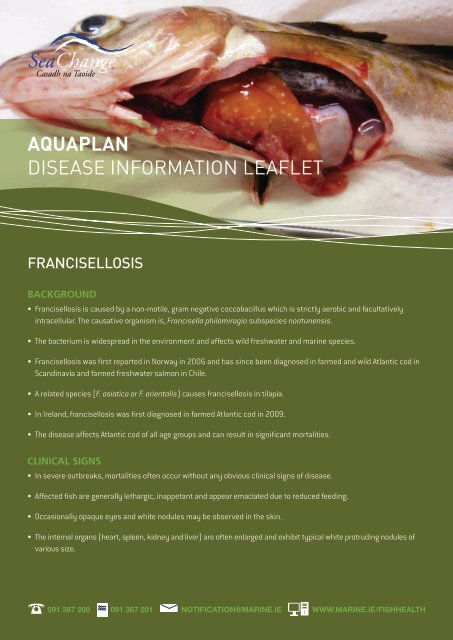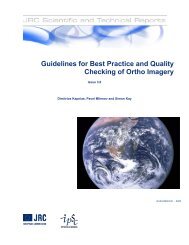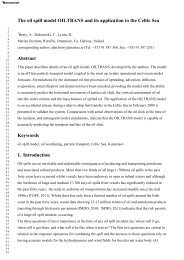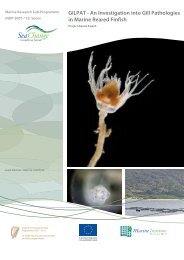Download disease information leaflet on ... - Marine Institute
Download disease information leaflet on ... - Marine Institute
Download disease information leaflet on ... - Marine Institute
- No tags were found...
You also want an ePaper? Increase the reach of your titles
YUMPU automatically turns print PDFs into web optimized ePapers that Google loves.
SeaChangeCasadh na TaoideAQUAPLANDISEASE INFORMATION LEAFLETFRANCISELLOSISBACKGROUND• Francisellosis is caused by a n<strong>on</strong>-motile, gram negative coccobacillus which is strictly aerobic and facultativelyintracellular. The causative organism is, Francisella philomiragia subspecies noatunensis.• The bacterium is widespread in the envir<strong>on</strong>ment and affects wild freshwater and marine species.• Francisellosis was first reported in Norway in 2006 and has since been diagnosed in farmed and wild Atlantic cod inScandinavia and farmed freshwater salm<strong>on</strong> in Chile.• A related species ( F. asiatica or F. orientalis) causes francisellosis in tilapia.• In Ireland, francisellosis was first diagnosed in farmed Atlantic cod in 2009.• The <str<strong>on</strong>g>disease</str<strong>on</strong>g> affects Atlantic cod of all age groups and can result in significant mortalities.CLINICAL SIGNS• In severe outbreaks, mortalities often occur without any obvious clinical signs of <str<strong>on</strong>g>disease</str<strong>on</strong>g>.• Affected fish are generally lethargic, inappetant and appear emaciated due to reduced feeding.• Occasi<strong>on</strong>ally opaque eyes and white nodules may be observed in the skin.• The internal organs (heart, spleen, kidney and liver) are often enlarged and exhibit typical white protruding nodules ofvarious size.091 387 200 091 387 201notificati<strong>on</strong>@marine.ie www.marine.ie/fishhealth
DIAGNOSIS• Diagnosis of francisellosis is based <strong>on</strong> clinical signs, histopathological changes and laboratory investigati<strong>on</strong>s.• C<strong>on</strong>firmati<strong>on</strong> of the diagnosis requires isolati<strong>on</strong> of the bacterium <strong>on</strong> selective media (cysteine heart agar with 5%sheep blood) with serological or molecular identificati<strong>on</strong> of the causative agent.• The bacterium grows within the temperature range of 10 – 30°C, with an optimal growth temperature of 22°C.• Histopathologically, affected organs show extensive inflammati<strong>on</strong> with multiple granulomas.CONTROL• There is currently no effective vaccine treatment for francisellosis.• Although the bacterium has been reported to be sensitive to tetracyclines, treatments to date havebeen unsuccessful.• The bacterium is present in the skin and mucus of infected fish and can survive for l<strong>on</strong>g periods outside the hostsuggesting that horiz<strong>on</strong>tal transmissi<strong>on</strong> plays an important role in the spread of <str<strong>on</strong>g>disease</str<strong>on</strong>g>.• Strict <strong>on</strong>-site biosecurity measures and screening of incoming stocks should form part of a c<strong>on</strong>trol strategy.WHAT SHOULD I DO?• Minimise potentially stressful procedures such as handling and grading when francisellosis is suspected orc<strong>on</strong>firmed.• As francisellosis is not listed under Council Directive 2006/88/EC, c<strong>on</strong>trol of the <str<strong>on</strong>g>disease</str<strong>on</strong>g> is a matter for the operatorand the retained veterinary practiti<strong>on</strong>er.• Strict biosecurity measures should be implemented around the infected site.• Remove moribund and dead fish from infected pens/tanks daily. Mortalities should be disposed of in accordance withcurrent Animal By-Products Regulati<strong>on</strong>s.• If the vet notices a change in the nature of the infecti<strong>on</strong> and suspects a more virulent <str<strong>on</strong>g>disease</str<strong>on</strong>g> is emerging oralternatively, if the <str<strong>on</strong>g>disease</str<strong>on</strong>g> is suspected in a new host species, you should c<strong>on</strong>tact the Fish Health Unit of the <strong>Marine</strong><strong>Institute</strong>. If you suspect the presence of a listed <str<strong>on</strong>g>disease</str<strong>on</strong>g> you should also notify the <strong>Marine</strong> <strong>Institute</strong>.AquaPlan (Grant-Aid Agreement No. PBA/AF/08/003(01)) is carried out under the Sea Change strategy with the support of the <strong>Marine</strong> <strong>Institute</strong> and the <strong>Marine</strong> ResearchSub-Programme of the Nati<strong>on</strong>al Development Plan 2007-2013, co-financed under the European Regi<strong>on</strong>al Development Fund.For as na MaraVet-Aqua Internati<strong>on</strong>alEUROPEAN REGIONALDEVELOPMENT FUNDPhotographs © <strong>Marine</strong> <strong>Institute</strong> & Vet Aqua Internati<strong>on</strong>al.
















